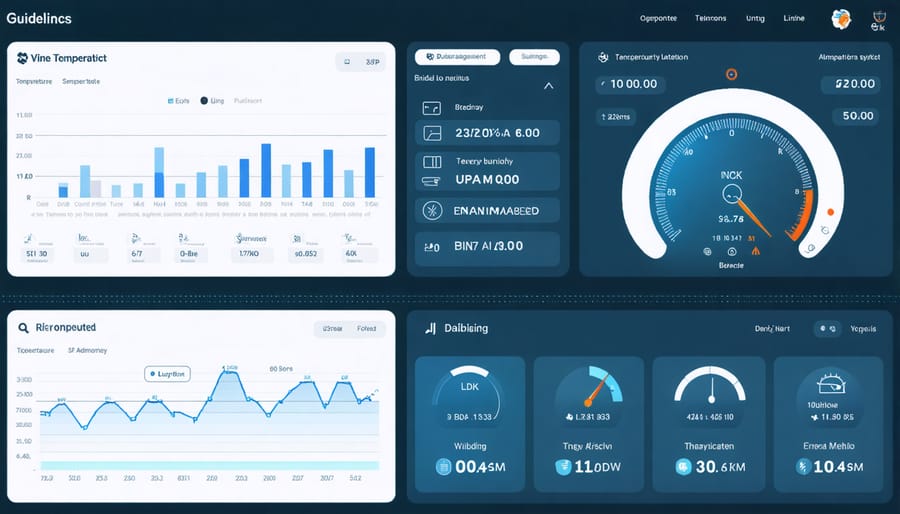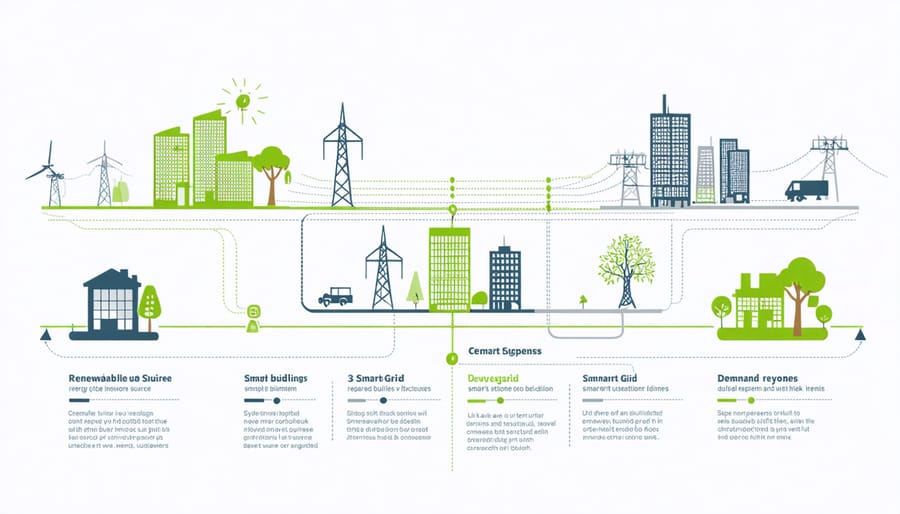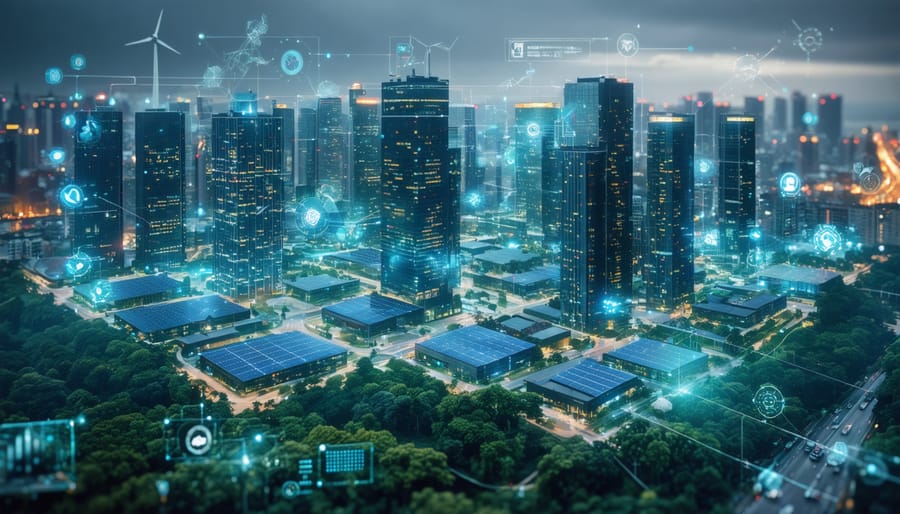The race toward sustainable urban development has positioned smart building technologies at the forefront of modern construction innovation. Energy smart buildings represent a paradigm shift in how we conceptualize, construct, and operate commercial and residential structures. By integrating advanced automation systems, IoT sensors, and artificial intelligence, these buildings optimize energy consumption while maintaining optimal occupant comfort. Industry data reveals that smart buildings reduce energy costs by 30-50% compared to conventional structures, while simultaneously decreasing carbon emissions and improving operational efficiency. For construction professionals and property developers, this technological evolution presents both an unprecedented opportunity and an imperative to adapt. The convergence of building management systems (BMS), predictive analytics, and renewable energy integration is transforming passive structures into dynamic, responsive environments that actively participate in grid optimization and sustainable urban development. As global energy demands intensify and environmental regulations tighten, mastering energy smart building principles has become essential for staying competitive in today’s construction landscape.

The Core Technologies Driving Energy Smart Buildings
Advanced Building Management Systems (BMS)
Modern building management systems represent the central nervous system of energy smart buildings, orchestrating various building operations through sophisticated automation and control mechanisms. These integrated platforms leverage artificial intelligence and machine learning algorithms to optimize energy consumption, maintain occupant comfort, and ensure operational efficiency across all building systems.
At their core, advanced BMS solutions incorporate real-time monitoring and predictive analytics capabilities. They continuously collect data from thousands of sensors distributed throughout the building, measuring parameters such as temperature, humidity, occupancy levels, lighting conditions, and energy consumption patterns. This data is processed through intelligent algorithms that make automated decisions to optimize building performance.
Key features of contemporary BMS include demand-response functionality, which automatically adjusts building systems based on grid conditions and energy pricing; predictive maintenance protocols that identify potential equipment failures before they occur; and adaptive learning capabilities that fine-tune building operations based on historical performance data and occupancy patterns.
Integration capabilities are crucial, allowing BMS to communicate with various building subsystems, including HVAC, lighting, security, and fire safety systems. This seamless integration enables coordinated responses to changing conditions and ensures optimal resource utilization while maintaining compliance with building codes and environmental regulations.

IoT Sensors and Real-time Monitoring
IoT sensors and real-time monitoring systems form the backbone of energy smart buildings, enabling precise control and optimization of building operations. These sophisticated networks comprise various sensor types, including occupancy detectors, temperature sensors, humidity monitors, and power consumption meters, all working in concert to create a comprehensive building intelligence system.
The sensor infrastructure typically operates on a three-tier architecture: data collection, processing, and analysis. Environmental sensors monitor indoor air quality, temperature variations, and lighting levels, while energy meters track consumption patterns across different building zones. Advanced motion and occupancy sensors enable dynamic adjustment of HVAC and lighting systems based on real-time usage patterns.
Data from these sensors is collected through wireless protocols such as BLE, Zigbee, or LoRaWAN, ensuring reliable communication while minimizing power consumption. Building management systems (BMS) integrate this data through gateway devices, creating a centralized platform for monitoring and control. Modern systems employ edge computing capabilities to process data locally, reducing latency and enabling immediate responses to changing conditions.
The real value emerges from the analytics layer, where artificial intelligence and machine learning algorithms process the collected data to identify patterns, predict maintenance needs, and optimize energy usage. According to industry studies, buildings utilizing comprehensive IoT monitoring systems typically achieve 15-30% reduction in energy consumption compared to conventional buildings.

Integration with Smart Grid Systems
Demand Response Management
Demand Response Management (DRM) represents a critical component in energy smart buildings, enabling dynamic optimization of energy consumption based on grid conditions and pricing signals. Through advanced Building Management Systems (BMS), facilities can automatically adjust their energy usage during peak demand periods, resulting in significant cost savings and improved grid stability.
Modern DRM systems utilize sophisticated algorithms to analyze real-time data from multiple sources, including utility pricing signals, weather forecasts, and occupancy patterns. When electricity demand peaks or prices surge, these systems can automatically implement pre-programmed responses, such as adjusting HVAC settings, dimming non-essential lighting, or temporarily reducing power to non-critical equipment.
Case studies have demonstrated that buildings implementing DRM systems typically achieve 15-30% reduction in peak demand charges. For instance, a commercial office building in Singapore reduced its peak load by 22% through automated load shifting and strategic equipment scheduling.
The effectiveness of DRM relies heavily on integration with other building systems and proper configuration of response parameters. Building operators can establish hierarchical control protocols that prioritize occupant comfort while maximizing energy savings. Advanced features include predictive capabilities that anticipate demand spikes and automatic participation in utility demand response programs.
For optimal results, DRM should be implemented as part of a comprehensive energy management strategy, incorporating smart meters, IoT sensors, and automated control systems. This integration ensures buildings can respond dynamically to changing grid conditions while maintaining operational efficiency and occupant comfort.
Renewable Energy Integration
The integration of renewable energy sources represents a cornerstone of energy smart building design, fundamentally transforming how buildings generate and consume power. Solar photovoltaic systems, typically installed on rooftops or integrated into building facades, serve as primary renewable sources, capable of meeting 30-60% of a building’s energy demands when properly implemented.
Modern energy smart buildings increasingly incorporate hybrid renewable systems, combining solar with other sustainable sources such as ground-source heat pumps and small-scale wind turbines. These integrated systems work in concert with advanced energy management platforms that optimize power generation and consumption patterns in real-time.
Energy storage solutions, particularly lithium-ion battery systems, play a crucial role in renewable integration by addressing intermittency issues. These systems store excess energy during peak production periods for use during low-generation times or high-demand periods, ensuring consistent power supply and reducing grid dependency.
Building-integrated photovoltaics (BIPV) represent an innovative approach, incorporating solar-generating materials directly into construction elements like windows, skylights, and facade panels. This dual-functionality not only generates power but also reduces material costs and enhances architectural aesthetics.
The success of renewable integration depends heavily on sophisticated control systems that balance multiple energy sources, storage systems, and building loads. Modern building management systems (BMS) utilize artificial intelligence and machine learning algorithms to predict energy needs and optimize renewable resource utilization, resulting in maximum efficiency and cost savings.
Real-World Implementation Case Study
The Edge, Deloitte’s headquarters in Amsterdam, stands as a pioneering example of energy smart building implementation, achieving the highest BREEAM sustainability score ever recorded of 98.36%. This 40,000-square-meter facility, completed in 2015, demonstrates how integrated smart technologies can maximize energy efficiency while enhancing occupant comfort and productivity.
The building incorporates over 28,000 sensors that monitor movement, lighting levels, humidity, and temperature. These sensors connect to a central building management system that continuously optimizes energy usage. The lighting system, comprising LED panels powered by ethernet cables, automatically adjusts based on occupancy and natural light levels, reducing electricity consumption by 80% compared to conventional office buildings.
Solar panels installed on the building’s facade and roof, combined with aquifer thermal energy storage beneath the building, generate more electricity than the building consumes. The Edge utilizes rainwater harvesting systems and grey water recycling, resulting in 70% less water consumption than typical office buildings.
What sets this project apart is its innovative approach to workspace utilization. The building’s smart system tracks space usage through employees’ smartphones, directing them to available workspaces and parking spots, significantly reducing energy waste in unused areas. Real-time occupancy data enables precise control of heating, cooling, and ventilation systems, maintaining optimal comfort levels while minimizing energy consumption.
The implementation faced several challenges, particularly in integrating multiple building systems into a cohesive network. The project team overcame these obstacles by developing a custom API that enables seamless communication between different technological components. The initial investment of €76 million was justified through operational cost savings of approximately €2.5 million annually.
Key performance metrics after three years of operation include:
– 70% reduction in energy consumption compared to traditional office buildings
– Net-zero energy status achieved through renewable energy generation
– 60% reduction in maintenance costs through predictive maintenance
– 25% increase in workspace utilization efficiency
The success of The Edge has influenced numerous smart building projects worldwide, establishing new benchmarks for sustainable architecture. The project demonstrates that while the initial investment in smart building technology may be substantial, the long-term benefits in terms of energy savings, operational efficiency, and occupant satisfaction make it a compelling business case for future commercial developments.
The project’s implementation process has become a model for other smart building initiatives, emphasizing the importance of early stakeholder engagement, comprehensive system integration planning, and continuous performance monitoring and optimization.
Economic and Environmental Benefits
Energy smart buildings deliver substantial financial returns while significantly reducing environmental impact, making them increasingly attractive to property developers and building owners. Studies demonstrate that implementing smart building technologies can lead to energy cost savings of 20-30% annually through optimized HVAC operations, intelligent lighting controls, and automated energy management systems.
Recent case studies from commercial developments show that smart buildings typically achieve ROI within 3-5 years through reduced operational costs. Beyond direct energy savings, these buildings command premium rental rates and higher occupancy levels due to enhanced comfort and sustainability credentials. Building owners report maintenance cost reductions of up to 15% through predictive maintenance and real-time monitoring systems.
From an environmental perspective, smart buildings contribute significantly to carbon reduction goals. Advanced building management systems can reduce CO2 emissions by 30-50% compared to conventional buildings. Water consumption typically decreases by 30-50% through smart metering and leak detection systems. The integration of renewable energy sources, facilitated by intelligent grid management, further enhances environmental benefits.
These buildings also demonstrate improved resource efficiency through waste reduction and materials optimization. Smart waste management systems can reduce disposal costs by up to 20%, while automated inventory systems minimize material wastage during operations. The long-term durability of smart building systems, coupled with their ability to adapt to changing requirements, extends the building’s lifecycle and reduces replacement costs.
Industry analysis indicates that buildings implementing comprehensive smart technologies achieve LEED certification more easily and maintain higher asset values over time. The combination of reduced operational costs, enhanced building performance, and demonstrated environmental benefits makes energy smart buildings increasingly essential in modern sustainable construction.
Energy smart buildings represent a crucial cornerstone in our transition towards sustainable urban development. As we’ve explored throughout this article, the integration of advanced technologies, intelligent management systems, and energy-efficient design principles has revolutionized how buildings operate and perform. The demonstrated benefits – from substantial energy cost savings to enhanced occupant comfort and reduced environmental impact – make a compelling case for widespread adoption.
Looking ahead, the future of energy smart buildings appears increasingly promising. Emerging technologies such as artificial intelligence, machine learning, and the Internet of Things continue to evolve, offering even more sophisticated solutions for building energy management. The integration of renewable energy systems, coupled with advanced storage solutions, will further enhance the self-sufficiency and resilience of smart buildings.
However, successful implementation requires a coordinated effort from all stakeholders – architects, engineers, contractors, and building owners. The initial investment in smart building technologies, while significant, consistently proves worthwhile through long-term operational savings and increased property value.
As climate change concerns intensify and energy efficiency regulations become more stringent, energy smart buildings will transition from being a competitive advantage to an essential standard in construction. Industry professionals who embrace these innovations now will be better positioned to meet future challenges and requirements. The path forward is clear: energy smart buildings are not just a trend but a fundamental shift in how we design, construct, and operate our built environment.

